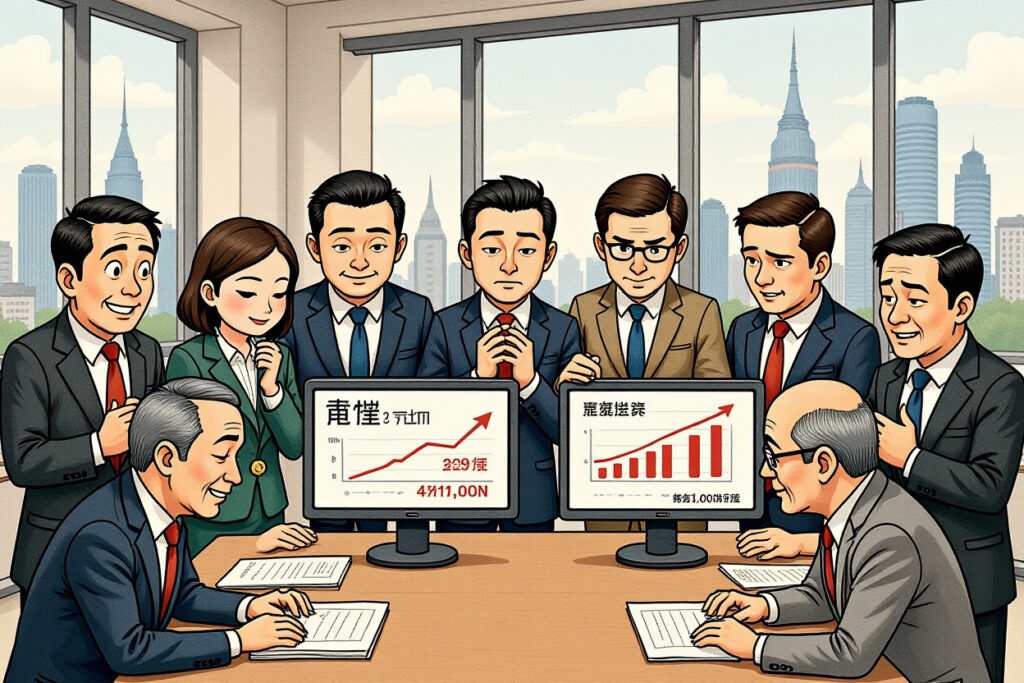Capital Momentum Builds in Chinese Equity Markets
Chinese equity markets are experiencing a remarkable convergence of capital inflows, creating one of the most dynamic investment environments in recent years. Five distinct capital sources have emerged as primary drivers of market momentum, each contributing to the sustained upward trajectory of A-shares. The critical question for sophisticated investors remains: which of these capital sources demonstrates the strongest sustainability amid evolving market conditions?
The period from July through August 2025 witnessed accelerated capital deployment across multiple channels, with net inflows expanding significantly compared to previous months. This coordinated capital movement represents a fundamental shift in market participation patterns, suggesting deeper structural changes in how both domestic and international investors view Chinese equity opportunities.
Key Market Developments
– Margin financing inflows doubled in August, reaching 274.45 billion yuan
– Foreign investment activity through Stock Connect programs hit record levels
– Private fund registrations surged to their highest level since 2022
– Retail investor participation increased substantially year-over-year
– Household savings exceeding 161 trillion yuan represent massive potential capital deployment
Margin Financing Surge Demonstrates Investor Confidence
Margin financing (融资资金) has reemerged as a powerful force in Chinese equity markets, with August figures showing remarkable strength. As a crucial leverage mechanism, margin financing provides valuable insight into professional investor sentiment and risk appetite.
The sustained capital inflows through margin channels reached 274.445 billion yuan in August, doubling July’s 132.879 billion yuan and establishing a new阶段性新高 (stage high). This dramatic increase signals growing confidence among sophisticated market participants who utilize leverage to amplify their positions.
2025 Margin Financing Evolution
The trajectory of margin financing throughout 2025 reveals a fascinating pattern of recovery and acceleration. January through April witnessed significant volatility, with April experiencing a net outflow of 131.87 billion yuan. However, the trend reversed decisively beginning in May:
– May: 13.544 billion yuan net inflow
– June: 48.913 billion yuan net inflow
– July: 132.879 billion yuan net inflow
– August: 274.445 billion yuan net inflow
This progressive acceleration demonstrates how margin financing has transformed from a source of market uncertainty to a pillar of support for equity prices. The sustained capital inflows through leverage channels now represent a fundamental component of market structure.
Foreign Investment Activity Reaches Historic Levels
International capital has returned to Chinese markets with unprecedented vigor, as evidenced by Stock Connect program activity. Foreign investors have dramatically increased their participation, bringing not only capital but also enhanced market efficiency and global perspective.
The August average daily turnover through Northbound trading reached 294.227 billion yuan, representing a 45.8% increase from July’s 202.428 billion yuan and setting a new historical record. The momentum continued into September, with average daily turnover climbing to 320.650 billion yuan, another 9% increase month-over-month.
Foreign Participation Trajectory
The reactivation of foreign investor interest follows a period of relative caution earlier in the year. From January to May, average monthly turnover fluctuated between 130-220 billion yuan, reaching a low of 138.788 billion yuan in May. The turning point arrived in June, beginning a four-month expansion:
– June: 148.521 billion yuan
– July: 202.428 billion yuan
– August: 294.227 billion yuan
– September: 320.650 billion yuan
This represents a 116% increase in just four months, indicating a fundamental reassessment of Chinese equity opportunities among international institutional investors. The sustained capital inflows from foreign sources contribute significantly to market depth and pricing efficiency.
Private Fund Expansion Accelerates
Private securities investment funds (私募证券投资基金) have emerged as another powerful source of market capital, with registration activity reaching multi-year highs. These professionally managed vehicles represent sophisticated domestic capital seeking equity exposure.
July witnessed 79.281 billion yuan in new private fund registrations, dramatically exceeding June’s 29.983 billion yuan and marking the highest monthly figure since 2022. Simultaneously, overall assets under management for private securities funds increased by 325.4 billion yuan in July alone.
2025 Private Fund Dynamics
The evolution of private fund activity throughout 2025 demonstrates a clear pattern of accelerating commitment to equity markets:
– January: 25.372 billion yuan in new registrations
– February: 15.211 billion yuan (affected by Spring Festival)
– March-May: 30-45 billion yuan monthly range
– June: Beginning of accelerated growth
– July: 79.281 billion yuan, exceeding 700 billion yuan threshold
This represents a four-fold increase from the lowest monthly reading, indicating substantial capital reallocation into equity strategies. The scale of July’s asset growth at 325.4 billion yuan far exceeds previous months, with only April showing comparable expansion at 256.7 billion yuan. While August data remains unpublished, market activity suggests continued strength in private fund capital deployment.
Retail Investor Participation Intensifies
Individual investors have returned to markets with renewed enthusiasm, complementing institutional capital flows. Though specific account opening data requires fuller disclosure, market feedback and high-frequency indicators confirm significantly increased retail participation year-over-year.
The resurgence of individual investors represents a crucial development for market breadth and stability. Retail participants historically demonstrate different behavioral patterns than institutional investors, contributing to market liquidity and diversity of perspective. The combination of increased retail participation and expanding margin financing creates a powerful feedback mechanism that amplifies market momentum.
Historical Patterns and Current Dynamics
Market history demonstrates a strong correlation between retail investor participation and perceived赚钱效应 (money-making effects). As major indices have advanced throughout 2025, the apparent profitability of equity investments has attracted new participants. This creates a self-reinforcing cycle where market gains attract new capital, which in turn supports further appreciation.
The current environment appears to be activating this historical pattern, with sustained capital inflows from retail sources complementing institutional participation. This broad-based market engagement typically supports more durable advances than those driven solely by institutional activity.
Household Savings Represent Massive Potential
The enormous pool of household savings represents perhaps the most significant potential source of future equity inflows. With household deposit balances reaching 161 trillion yuan, even a modest reallocation could generate substantial market impact.
Historical analysis confirms that major bull markets in Chinese equities have consistently involved significant participation from household capital. The current environment appears particularly conducive to such reallocation, with bank deposit and wealth management product yields at historical lows while equity market returns show improving potential.
Changing Savings Patterns
The pattern of household savings growth has undergone a notable shift in recent periods. From 2019 through 2024, household deposits grew at exceptionally high rates. However, beginning in March 2025, this growth rate has noticeably moderated.
This deceleration coincides with improving equity market performance and declining fixed income yields, creating powerful incentives for capital redeployment. The sheer scale of household savings—161 trillion yuan—means that even a 1% reallocation would represent 1.61 trillion yuan of potential equity demand.
Sustainability Assessment Across Capital Sources
Evaluating the durability of various capital sources requires analyzing their fundamental drivers and historical patterns. Each category demonstrates different characteristics that influence its likely persistence.
Margin financing typically shows higher volatility than other sources, responsive to both market conditions and regulatory changes. While current levels appear sustainable in the near term, leverage-based inflows often prove sensitive to market corrections. Foreign investment flows demonstrate different dynamics, influenced by global risk appetite, currency expectations, and relative valuation assessments.
Comparative Sustainability Analysis
– Margin financing: Moderate sustainability, subject to regulatory changes and market volatility
– Foreign investment: High sustainability if economic fundamentals remain strong and currency stable
– Private funds: High sustainability, representing professional capital allocation decisions
– Retail investment: Moderate sustainability, influenced by market performance and sentiment
– Household savings reallocation: Potentially very high sustainability if trend establishes
The sustained capital inflows from private funds and potential household savings reallocation appear most promising for extended durability. These sources represent structural shifts in capital allocation rather than tactical positioning.
Market Implications and Investment Considerations
The convergence of multiple capital sources creates a powerful foundation for continued market advancement. However, investors should consider several factors when evaluating opportunities created by these inflows.
Sector rotation patterns often emerge during periods of sustained capital inflows, with different categories of investors favoring different segments of the market. Foreign investors typically show preference for large-cap, liquid names with strong governance, while domestic investors may pursue different opportunities.
Strategic Allocation Considerations
Investors should monitor flow data regularly through sources like the China Securities Regulatory Commission (中国证监会) disclosures and Shanghai/Shenzhen Stock Exchange reports. Particular attention should focus on whether inflow momentum continues across multiple categories or becomes concentrated in specific areas.
The current environment suggests broad-based strength, but historical patterns indicate that diversified inflow sources typically support more sustainable advances. The sustained capital inflows appearing across investor categories provide confidence in market trajectory.
Forward Outlook and Risk Factors
The sustainability of capital inflows depends on both domestic economic conditions and global factors. Several developments could influence flow patterns in coming months.
Domestically, corporate earnings growth, policy support measures, and currency stability will significantly impact investor confidence. Globally, interest rate environments, geopolitical developments, and emerging market flows will affect foreign investment patterns.
Monitoring Indicators
Investors should track several key metrics to assess inflow sustainability:
– Monthly margin financing balance changes
– Northbound trading volumes and net purchases
– Private fund registration and performance data
– New investor account statistics
– Household deposit growth rates and composition
These indicators provide early warning of changing flow patterns that might signal market inflection points.
Strategic Implications for Professional Investors
The current capital inflow environment creates both opportunities and challenges for institutional investors. The diversity of capital sources suggests broader market participation than during previous advance phases.
For global investors, understanding the dynamics between different investor categories becomes increasingly important. The interaction between domestic and foreign capital, between leveraged and unleveraged positions, and between institutional and individual flows creates complex market dynamics that influence both opportunity and risk.
The sustained capital inflows across multiple channels provide strong fundamental support for Chinese equities. However, investors should maintain disciplined risk management practices, particularly as valuations advance and leverage increases. The diversity of capital sources provides some protection against sudden reversals in any single category, but correlated behavior during stress periods remains a consideration.
Monitor flow data through official channels and adjust allocations as sustainability patterns become clearer. The current environment offers significant opportunity, but requires careful attention to evolving capital dynamics.




